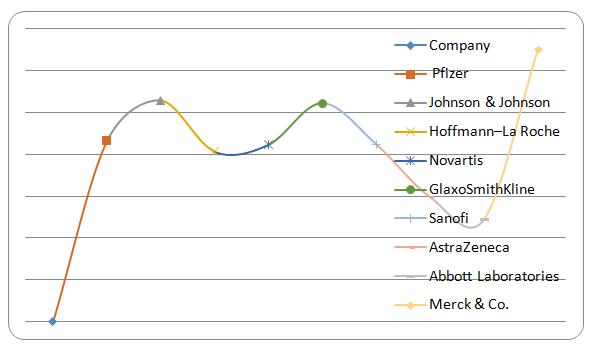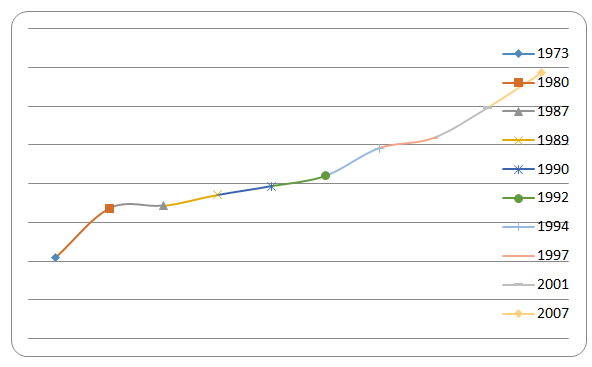Introduction
The global spending on drugs has increased over the years and in the year 2006 it reached an all-time high of over $ 643 billion (Schoonveld 8). These revenues are mostly concentrated in the US, Europe and Japan with the US accounting for almost half of the pharmaceutical revenues in the world.
However, emerging markets have also been identified to grow rapidly in the last few years with countries such as Russia, Mexico, Brazil, China and South Korea growing their consumption of prescription drugs by up to 81 percent.
It has been identified that in the US stock exchange, the performance of pharmaceutical companies is ranked higher than the other fortune five hundred companies with returns of over 17 percent on revenues (Ajami 158).
Largest pharmaceutical companies according to prescription sales
Pfizer
Pfizer has been identified as one of the largest pharmaceutical companies in the world and is ranked first in terms of revenues (Lepore 1). It was initially established in 1849 and over the years it has grown to be listed in a couple of stock exchanges in the world.
Over the years, the company has also acquired a huge market share through mergers with companies such as Warner–Lambert, Parke–Davis, Agouron, Pharmacia, Sugen, Wyeth and King Pharma. It has its headquarters in Midtown Manhattan in New York while its research headquarters are in Groton Connecticut.
The company has divided its products into two different business segments. These are the bio-pharmaceutical and the diversified business segments.
The bio-pharmaceutical business segment includes products which prevent as well as treat cardiovascular and metabolic diseases, arthritis and pain, eye disease, infectious and respiratory diseases, cancer, central nervous system disorders, endocrine disorders and urogenital conditions (Lepore 2). The diversified business segment has Animal as well as Consumer products (Lepore 5).
Their research and development departments are dedicated to identifying, and developing products that will alleviate the medical deficiencies that are inherent in the world. The company actively spent $9.4 billion in the 2010 financial year, $7.8 billion in the 2009 financial year and $7.9 billion in the 2008 financial year on their research and development programs (Lepore 6).
The company’s revenues from their business outside the US accounted for about 57 percent of their total revenues in the year 2010 with Japan being their second largest market which contributed 7.5 percent of their total revenues (Lepore 7).
Their international operations have not been without challenges as the company struggles with capital and exchange control regulations, expropriation, other restrictive government actions such as laws and regulations on pricing and currency fluctuations.
Novartis
Novartis was founded in 2003 and is based in Basel, Switzerland. It has been ranked the second largest pharmaceutical company in the world in terms of revenues.
Over the years it has grown through the setting up of subsidiaries as well as acquisitions and mergers with other companies. It has also sold some of its subsidiaries in the past, such as Gerber Products Company to Nestlé, which used to produce their infant and baby products.
The company has a range of products which include cost-saving generic pharmaceuticals, preventive vaccines and diagnostic tools, eye care, over-the-counter medications, innovative medicines and animal health products, which are categorized into five business segments namely Pharmaceuticals, Alcon, Vaccines and Diagnostics, Sandoz and finally Consumer Health (Ehrat 20).
The company spends a lot on their research and development programs, which are spread across each of their divisions with over 9.6 billion US dollars being spent on the same in 2011 alone. This ensures that the company has a concrete footing on the medical needs of the world through a constant supply of new products that are market specific.
Their research and development programs also complement the efforts of their drug development activities by constantly testing for any new risks and uncertainties that may be posed by the drugs that they produce to both the company and their customers (Ehrat 164).
Sanofi
Sanofi is a French pharmaceutical company with its headquarters in Paris, France. It is currently ranked the world’s third largest pharmaceutical company in terms of revenues. Its revenues are mainly drawn from the research and development activities, as well as the manufacturing and marketing of prescription drugs (Linehan 158).
In 2004 the company came to be known as Sanofi-Aventis after its acquisition of Aventis co. Some of its other subsidiaries include Zentiva, Sanofi Pasteur, Shantha Chattem, Biotechnics, Genzyme, Medley and Nichi-Iko. The company mainly focuses on the diabetes and oncology products as well as other flagship products in the anti-thrombotic and cardiovascular fields (Linehan 24).
Merck & co.
Merck & Co. is ranked as the fourth largest pharmaceutical company in the world and has its headquarters in Whitehouse Station, New Jersey. It was initially established as a subsidiary of a German company back in 1891, but the US confiscated it during World War I and later made it an independent American company in 1917.
The company has been identified to base its operations on research and development as they seek to discover, design, develop and market innovative pharmaceutical products that improve the health of humans as well as animals all over the world (Frazier 3).
They have managed to achieve this directly and through joint ventures with other pharmaceutical companies (Frazier 7). The company is also known for the Merck manuals, which are reference books for those in the medical and pharmacy fields.
Comparison
One of the aspects of the world’s top pharmaceutical companies, that stands out is their concentration and investment on research and development programs. This is credited to the fact that most of the competition in the pharmaceutical business lies in the development of new products that are unique and serve to satisfy particular health needs.
Revenues for the largest pharmaceutical companies according to 2009 annual reports
For instance the development, manufacture and distribution of an erectile dysfunction drug called Viagra by Pfizer served to give them a great competitive edge in the market, as no other company had introduced such a drug in the market before (Schoonveld 265).
The need to increase their business capacity as well as their market share is characterized by the numerous mergers and acquisitions in the pharmaceutical industry and this has served to increase the total value as well as productivity of the industry in general. This may be the reason behind the higher net income that Merck co. as compared to other pharmaceutical companies.
Net incomes for the major pharmaceutical companies in the world

The four major pharmaceutical companies, however, differ in their business models, with other major pharmaceutical companies as Pfizer and Novartis are identified to produce both prescription and over-the-counter drugs for both human and animal health.
On the other hand, Sanofi chooses to concentrate their business model on the production of prescription drugs only while most major companies diversify their production so as to secure their revenue flows. Merck & co. chooses to concentrate on research and development as well as the publication of medical and pharmacy manuals, which makes them unique in the whole industry (Frazier 4).
Relationship between recessions and the increase in drug prices
The suggestion that since 1960 to 2011, each time when pharmaceutical prices spiked, it was followed by a U.S. economic recession can only be explained through a review of consumer spending on prescription drugs. It has been identified that the cost of drugs increase by a substantial amount all over the world and this can be explained through the particular increase in spending.
The amount of money in billion dollars that the total cost of drugs increased by during recessions

It has also been identified that American citizens spend over $289 billion a year on prescription drugs alone and this is a significant amount in the economy. Some people may argue that an increase in prices, even with a small margin will obviously have a significant impact on the economy and this directly translates to reduced savings and increased consumer spending (Schoonveld 127).
This has been known over the years to be followed by a general increase in interest rates so as to reduce the consumption and increase savings (Ajami 267).
With the inability of most citizens to meet their payments on credit advanced to them, defaults increase and the result is a negative ripple effect in the financial and credit markets as well as the entire economy in general. It may also be argued that during economic hardships people get sick often and, therefore, the demand for drugs goes up and subsequently their prices.
Works Cited
Ajami, Riad. International business: Theory and practice. New York: M.E. Sharpe. 2006. Print.
Ehrat, Felix. Annual report on Novartis Inc. Washington DC: United States Securities and Exchange Commission. 2011. Print.
Frazier, Kenneth. Annual report on Merck & co., inc. Washington DC: United States Securities and Exchange Commission. 2011. Print.
Lepore, Matthew. Annual report on Pfizer inc. Washington DC: United States Securities and Exchange Commission. 2011. Print.
Linehan, Karen. Annual report on Sanofi-Aventis. Washington DC: United States Securities and Exchange Commission. 2011. Print.
Schoonveld, Ed. The Price of Global Health: Drug Pricing Strategies to Balance Patient Access and the Funding of Innovation. New York: Gower Publishing. 2011. Print.